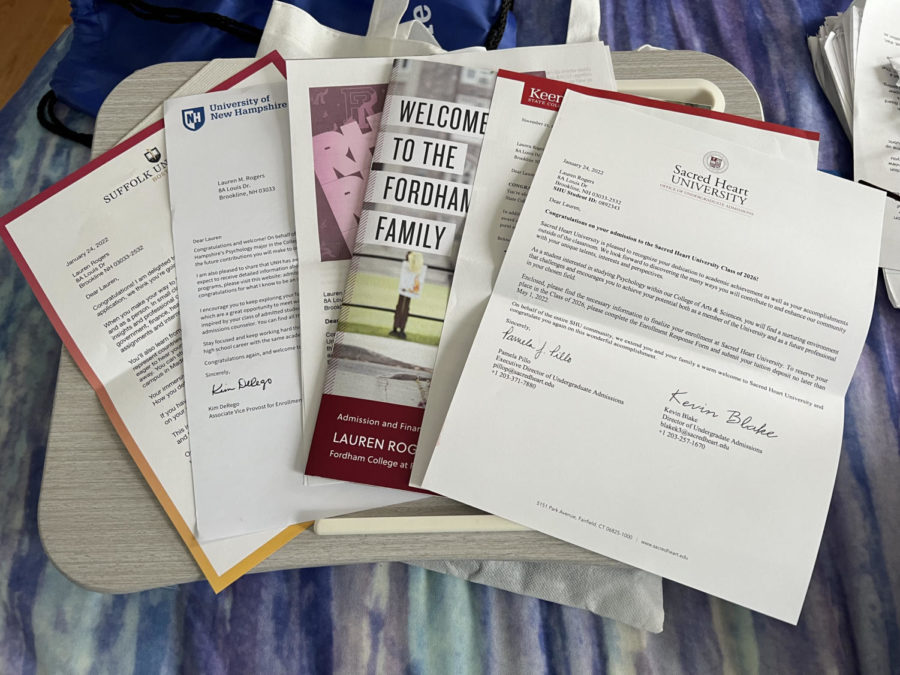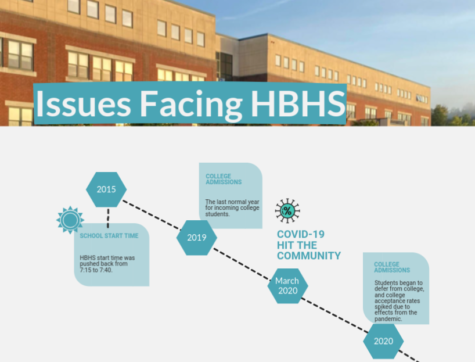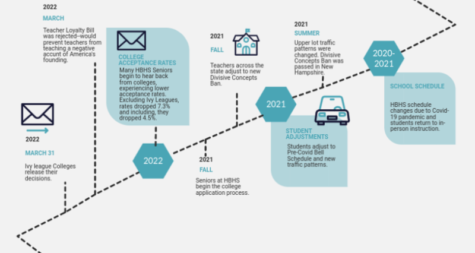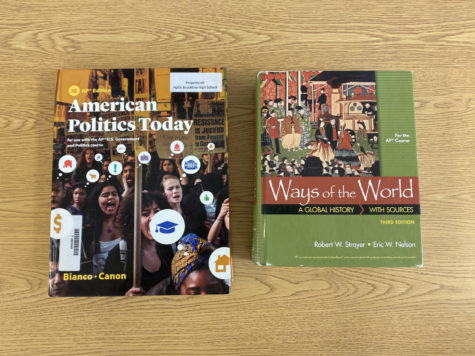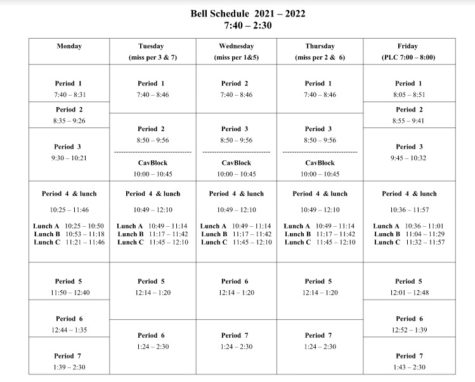Issues Facing Hollis Brookline High School
How the Critical Race Theory Debate Could Affect AP Designation, Rachel Lindof
“AP opposes censorship. AP is animated by a deep respect for the intellectual freedom of teachers and students alike. If a school bans required topics from their AP courses, the AP Program removes the AP designation from that course and its inclusion in the AP Course Ledger provided to colleges and universities,” states College Board.
At Hollis Brookline High School, AP courses are a very important part of education for many students. HBHS student Emma Andrews ‘22 says that it’s important for students to have the opportunity to take AP classes while in high school “because it can help prepare [students] for college–because the workload is not the same as a regular high school class, it is supposed to be the same as what a college class would be so it helps kids with the transition of going to college.” When a student completes an AP course, they not only gain the knowledge and information of the course, but they also gain experience in a college level course. At the end of the course, students have the opportunity to take the AP Exam, and if they score above a certain threshold, they then have the opportunity to use this highschool class count as college credit when they go to college.
Trevor Duval, HBHS AP Government and Civics teacher says that “We’re a school that takes a lot of pride in sending a lot of kids off to continue their education. Even though your normal level Civics classes and Econ classes are college preparatory, the rigor is not quite the same [as an AP course]; and for some students who are even able to take the AP test and have colleges accept that score for three or four college credits, there’s a huge financial saving as well,” he continues, “I think they are important for kids who take the classes for the right reasons.”
If teachers or schools alter the curriculum of an AP course to the point where it no longer aligns with the instruction put forth by College Board, then the AP designation for that course could be removed. With new legislation being put forth across the country, surrounding the topics of Critical Race Theory and Divisive Concepts, educators are becoming more limited in what they can teach. According to ABC News “New Hampshire is one of six states that have enacted policies based on anti-critical race theory rhetoric. The bill was introduced as a ban on ‘divisive concepts,’ and restricts the way educators can teach about race and gender in the classroom.” This bill along with other legislation at both the state and local levels have introduced some confusion and restrictions on teachers in New Hampshire. Jennifer Given, HBHS AP World History and World Studies teacher says, “I would say in my experience–and this is my 19th year–we don’t use CRT, we don’t teach CRT, I don’t think any of us even knew what it meant until it became a topic that people were concerned about. So I would say that first, it’s not a thing that we use. Second, I would say that in terms of how it impacts us, I think that people who have concerns about it are correct to express those concerns, what the problem is is that some people are overcorrecting the problem: it doesn’t exist in the schools so creating a solution isn’t necessary and then some of those solutions cause bigger problems.”
Duval explains that “one of the issues with the legislation is it’s unclear in some regards of what we can actually discuss and that itself I find to be very frustrating in my classes when we do class discussions I always like to take the role of devil’s advocate–you know, both sides to every argument, just to get kids to think about other perspectives and in some regards it seems like that legislation prevents that from happening” says Duval, “with this new legislation it feels like this fear of things we can discuss and the reasoning why things have happened have kind of impacted just what educators can do.”
Given continues that, “I’ve already become more restricted in what I teach in that the divisive concepts ban is on the books…we I think as a department are very conscious of what we are and are not doing and I don’t think that’s to the benefit of students–but we don’t have a lot of choices so I think we are very much self censoring already.” With teachers being limited in what they can discuss in their classrooms, it begs the question of how this may affect students here at HBHS. College Board which operates the AP Program, has continued to stand by their principle of intellectual freedom for both students and teachers. In the wake of much legislation across the country placing restrictions on what and how teachers are able to educate, this could mean that such an altercation of course materials could result in the revocation of AP accreditation for specific courses, from certain schools who may be required to alter course material so much as to the point where it no longer aligns with the curriculum put forth by College Board. If this were to happen at HBHS, there would be dramatic consequences. Duval says, “I think that you would see a tremendous amount of backlash which you might see take place in election cycles, or additional lawsuits being filed [against the state].”
The entire situation places teachers into a very difficult position however when College Board is saying one thing, and state legislation may be saying another. Given says, “on the one hand you could lose AP certification…on the other hand you could lose your actual teaching license if you violate the laws of the state in which you live. So you’re faced with a pretty challenging set of circumstances,” she continues, “I would venture to say that while I appreciate that AP is trying to protect the curriculum, I think that any teacher who is faced with potential job loss will default to being more careful because AP is less scary than losing your job so again, it’s not for the benefit of kids.”
New legislations across the country, state, and even here in Hollis and Brookline, are promoting limitations on certain course concepts and discussions. As this issue continues to unfold, and as the further legislation makes its way through the system, there’s no telling for certain what the future holds for classrooms, AP courses, students, and teachers across the state. Given explains that in light of the divisive concepts ban, “the consequences for teachers [that violate the ban] is that you could have your teaching license removed. So it’s not simply a ‘you’ll get spoken to and you’ll promise not to do it again’, it’s ‘you would lose your job, your livelihood, you would be unemployable.’”
College Acceptance Rates, Lauren Rogers
For the Class of 2022, college acceptance rates are dropping faster than ever before. Since the pandemic has died down, colleges have been getting more selective, even though they are seeing record highs in applications.
In 2019, University of New Hampshire(UNH)’s acceptance rate was 79%, which is seen as a less selective rate compared to other schools. Fordham University, which is around the mid-selective, was at 53%. And finally, a very selective school, Dartmouth College, an Ivy League, was at 8.8%.
Now, in 2022, UNH is estimated at 74%, Fordham at 43%, and Dartmouth at 6.2%. For each of these schools, this is considered a huge difference from their normal fluctuations in rates. UNH is a state school, meaning they need to accept a certain percentage of New Hampshire residents, and this percentage includes the In-State applications. So how selective have these schools become for incoming students? Out of the institutions researched, acceptance rates dropped on average 4.5%, and when the Ivy Leagues are factored out of the equation, the other schools dropped by 7.3% on average. These statistics come from a variety of searches among college websites.
Even standardized testing such as the SATs or ACTs were canceled in years prior, leading many colleges to go forward with a test-optional policy, with standardized tests no longer required for applications, many students decided to apply to more schools. This is likely one factor in what has lead to higher application rates and lower acceptance rates.
“I do think that COVID has affected our class in terms of acceptance rates, as many of my rejection letters stated that these colleges had record numbers of applicants and were forced to make difficult decisions among many qualified candidates. My theory is that in the remote learning period for colleges, some students chose to take gap years and wait until the schools opened up again, thus leading to a larger number of applicants this year.” said Michael Bauer, a senior at HBHS states,
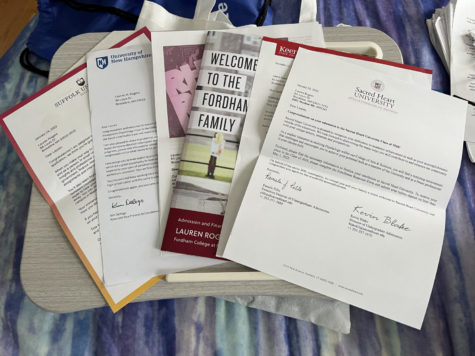 Bauer applied to 13 schools, all big names such as BC, Carnegie Mellon, Cornell, Dartmouth, Harvard, Johns Hopkins, Penn State, Purdue, Rensselaer Polytechnic Institute, Tufts, UNH, and Notre Dame. “I consider myself very lucky in that I did manage to get into my second choice school (BC), but I imagine that the vast majority of other applicants won’t have that same opportunity. I would say that generally, the college process was extremely stressful and resulted in a discouraging proportion of denials, at least for me,” said Bauer.
Bauer applied to 13 schools, all big names such as BC, Carnegie Mellon, Cornell, Dartmouth, Harvard, Johns Hopkins, Penn State, Purdue, Rensselaer Polytechnic Institute, Tufts, UNH, and Notre Dame. “I consider myself very lucky in that I did manage to get into my second choice school (BC), but I imagine that the vast majority of other applicants won’t have that same opportunity. I would say that generally, the college process was extremely stressful and resulted in a discouraging proportion of denials, at least for me,” said Bauer.
Aurora Holland, a senior at Nashua High School-North, states, “Overall every college I have heard back from has had lower acceptance rates than in past years, which I would assume is an impact of COVID.” Aurora applied to Harvard, Dartmouth, BU, RIT, MIT, and UNH, all of which have experienced a record high for applicants.
Colleges as a whole are struggling financially as well. Edward Hajduk, a professor at UMass-Lowell, states that “many higher education institutions rely heavily on housing income from the dormitories for their budgets. Not having the students in the dorms led to numerous budget shortfalls.”
Also due to remote learning, many students of the classes of 2020 and 2021 decided to defer their acceptances to avoid remote learning. Now that the pandemic has dwindled, most institutions have gone back to fully in-person learning. This means that any students from past years, may have chosen 2022 to enter academia.
Not just Ivy Leagues have lower acceptance rates however, most colleges are experiencing high application rates, while they are not able to give out as much aid or guarantee housing, and therefore are experiencing lower application rates.
Suffolk University stated in their acceptance letters that 2022 is by far the biggest applicant pool for them and others, and therefore are allowing interviews for freshman to spend their 1st year at the university’s Madrid campus, so that their Boston housing becomes available for upperclassmen.
However, some institutions have not dropped at all, and others’ acceptance rates have even risen from years prior. Keene State College and Colby College are just two out of the institutions researched that reported higher acceptance rates, and College of the Holy Cross and Stanford University both reported a maintained acceptance rate. Out of the 19 colleges researched, only four maintained or increased in their acceptance rates. So the class of 2022 may have to work a little bit harder to gain admission into their top schools.
From Washington Post Article: Applications boom, admit rates plummet: Prestige college admissions get a little crazier in the pandemic-by Nick Anderson
How Early School Start Times Affect Students, Kelsey Sova
One thing that most high school students lack is sleep. The more sleep a student gets, the better they do in school. “Insufficient sleep has also been shown to cause difficulties in school, including disciplinary problems, sleepiness in class and poor concentration,” said the American Psychological Association (APA). When teens aren’t getting enough sleep, their grades are bound to drop, so why not prevent that?
The biggest way to prevent poor grades and the risk of sleep deprivation would be to push school start times later. The American Academy for Pediatrics says that high school students should not start school before 8:30 am. Hollis Brookline High School used to attend school from 7:15am-2:24 p.m., but the Student Council for the 2014-15 school year originally proposed an 8:30 start time to the school board. Although they did not reach their goal, a compromise was made and the school hours adjusted to 7:40-2:30. “We did a really intensive study and I think it took them about a year, year and a half. They looked at the science, they looked at the whole, parents and students and community members and they all gave input,” said Jennifer Given, an HBHS social studies teacher and the union representative for the school. Given worked on the original proposal to push start time back as the Student Council advisor at the time.
The new start time decision came down to bussing. The bus routes need to remain as they are or the school would have to buy buses and hire additional drivers to pull off having later times. The projected cost of that was really really high and so they figured that this was a compromise, that maybe at some point we would be able to figure out that next step,” said Given. The biggest thing that would be affected by pushing the start time back would be the buses. This would still be the biggest problem if we changed the start time again. In order to make all of their routes, buses have to leave each school at a certain time. If we were to push the start time back for the high school, we would have to push the start time back for all six schools in the SAU 41 district. When the school start time was pushed back 25 minutes and the end time was pushed back by six, it was to accommodate the buses and their routes.
There are a lot of factors that go into play when adjusting school start and end times. “The first thing it would impact would be your end time. So right now the bell rings as 2:30, if we start 30 minutes later, your pushing things to 3:00 so it would have an impact on our dismissal and within that, after school activities, which is not to say that that should be the driving force but if your going to maintain equal instructional time, you move the start time you’ve got to move the end time so with that, if school went a half hour later, your 4:00 game at Oyster River or whatever where you would normally leave at 1:30 or whatever time to get there on time, now your missing an additional 30 minutes of instructional time to take part in extracurricular activities so that would be one aspect,” said HBHS principle Tim Grizone.
Another main argument would be traffic with most upperclassmen high schoolers driving themselves to school. “According to the National Highway Traffic Safety Administration, for example, drowsiness and fatigue cause more than 100,000 traffic accidents each year–and young drivers are at the wheel in more than half of these crashes,” said the APA. Most students spend an average of three hours on homework a night. Combine that with work and sports, and these students are going to bed at 11 p.m. or 12 a.m. at night, just to wake up at 6 a.m. for school. At HBHS, students learn that we should be getting between 7-9 hours of sleep each night. The majority of students are not in that range. With these students having less sleep, they are bound to do poorly in school.
So how does it affect students after doing this for 12 years? Emily Otte ‘22, who comes in late for senior options says “since I get up later I am able to get better sleep. Going into the REM cycle is important, it’s where you get the best sleep. I feel well rested and I do better in class.”
Otte thinks that pushing start time later would be a positive impact for the schools and the students. “I feel like we will get out later. if the start time was pushed later we would need the same amount of hours. I feel it would benefit all students, because they get to sleep in later. Like I said, they go to bed late and wake up early,” said Otte.
The senate recently passed a bill that would prevent us from moving the clocks back an hour in the fall and instead, maintain daylight savings. This bill, which would start in 2023, would make daylight savings permanent. In some northern states, this means during the winter months, the sun wouldn’t rise until about 9 am. This would cause major shifts in school scheduling and having to avoid the elementary schoolers getting on the bus in the dark, which is already being avoided due to safety concerns.
The board of education requires that schools be in session either 180 days or 1,050 hours. One way to explore options on ways to push back start time would be to switch our district from counting days to counting hours. We meet the amount of hours and are in fact 18 hours over the minimum, which totals to be about three school days, so the possibility to change start time is there.
There are so many factors that go into pushing back the start times, It is possible to push back start time, but it is just a huge process with a lot of people involved. It is possible to push start time back, and hopefully in the near future it can happen.
Parking Lot Traffic, Tucker Luter
Every school deals with traffic at the start and end of the day, but this year HBHS has seen or at least felt an increase in the traffic. In the afternoon there is consistently a line of cars from the stoplight at “4 Corners” all the way into the parking lot of the high school. This is roughly a mile of traffic; students are frustrated and frustration is only continuing to rise with gas prices increasing. People at the back of the line idle their cars for up to 30 minutes and then they still have to drive home.
The accidents in the parking lot and students coming to and from school seems high but that is to be expected with hundreds of new drivers. HB is not a big school either; it’s surrounded by farm fields and has only around 800 students.
Some changes from last year to this one that would affect traffic negatively is now instead of letting cars go before the bus leaves, administration holds everyone off until the buses are fully gone. Students rush to get in line to try to avoid the long wait and end up causing what can only be described as chaos with cars cutting off other people and a blob forming at the exit of the parking lot.
The traffic issues that do still exist in the morning seem to be caused by middle school having the same start time. The extra line does not seem to help the exiting traffic and at first might have even worsened the situation. The two lanes let more people sit in line causing traffic to not group up so much in the actual parking lot, but almost as soon as the two lanes start, it chokes off into one. Whatever time gained from the extra lane is lost in students trying to merge into one lane, some people not letting a car merge in or someone being too scared to merge causes delay. With the year being more than half way through, students have a pretty good system where the lines alternate who goes, this seems obvious but at first this was not happening.
The frustration seems to be at a peak right now. “Gas prices are through the roof, some people are practically running to their cars to try and get home faster. It was not a big deal when we were just losing time but now it’s costing us money,” said Brady Cheyne ‘22. Some students with less efficient gas prices are just waiting without even turning their cars on. “Now that it’s warm I either play ‘lax’ or hangout in the parking lot, plus I have to stay after anyway,” said Colin McGarry ‘22. Students have been theory crafting their own ideas as to why traffic is worse this year. The most popular opinion seems to be that it’s because staff won’t let cars go before the buses. Another opinion is because of the lower classmen not taking the bus. This might just be an excuse for upperclassmen to be upset at the sophomores and freshmen, but there could be some truth with that with more parents being home due to covid.
The traffic is also affecting parents, a parent of a sophomore said that “the traffic in the morning is ridiculous. I am 15 minutes of sitting in traffic to drop my kid off and sometimes as bad as 35 minutes leaving. It eats up my whole morning, and I’ve been late to my job a few times, and don’t even get me started on what’s happening with gas now. This problem is costing us money and we haven’t heard anything from the staff even acknowledging it.”
However, the traffic coming into school has certainly improved. With the additional lane so students can get around parents dropping students off, the line is nowhere near as bad as it could be.
Everyone is frustrated but most people are starting to adapt. Students have been seen showing up earlier and waiting till after the traffic dies down to leave. At the end of the day it mostly seems like people enjoy being frustrated or mad at something, compared to last year the change is not so significant.
